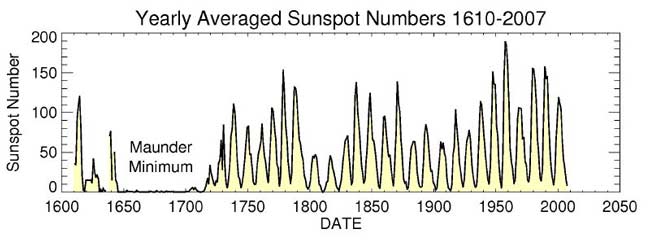Sun's Not Screwy, Scientist Says

Nothing is out of whack with the sun, a NASA researcher said this week, despite some scientists' suggestions that a lull in the weather there lately is unusually long, a phenomenon linked to at least one small ice age.
The sun goes through a roughly 11-year cycle of activity. It is now at or near the low point in that cycle, so sunspots are rare and solar flares infrequent.
At a conference earlier this year, scientists expressed concern that the low ebb was lasting longer than normal and that the inactivity might lead to a longer-term absence of sunspots. An unusually inactive solar cycle in the 17th century has been linked to the Little Ice Age that occurred around the same time.
The Maunder Minimum, as it's called, lasted 70 years, from 1645 to 1715.
"There have been some reports lately that solar minimum is lasting longer than it should. That's not true," said NASA solar physicist David Hathaway. The ongoing lull in sunspot numbers "is well within historic norms for the solar cycle."
The sun has been relatively quiet for more than two years. Hathaway said there were stretches in the 20th century when the slack periods lasted twice this long.
"It does seem like it's taking a long time," Hathaway said, "but I think we're just forgetting how long a solar minimum can last."
Get the Space.com Newsletter
Breaking space news, the latest updates on rocket launches, skywatching events and more!
Hathaway has studied sunspot data going back to 1749. While the cycle is commonly said to last 11 years, in fact its length can vary by more than a year.
Nobody knows what causes these fluctuations, but Hathaway does not expect the current lull to last.
"We have already observed a few sunspots from the next solar cycle," he said. "This suggests the solar cycle is progressing normally."
He expects the next solar maximum around 2012, when space storms should again become frequent. Scientist and others want to know, because the storms are known to knock out satellites and damage power grids on Earth. The storms can also increase risks to space travelers.
- Gallery: The Wild and Stormy Sun
- Vote: The Best Images of the Sun
- Video: Solar Storms
Join our Space Forums to keep talking space on the latest missions, night sky and more! And if you have a news tip, correction or comment, let us know at: community@space.com.

Space.com is the premier source of space exploration, innovation and astronomy news, chronicling (and celebrating) humanity's ongoing expansion across the final frontier. Originally founded in 1999, Space.com is, and always has been, the passion of writers and editors who are space fans and also trained journalists. Our current news team consists of Editor-in-Chief Tariq Malik; Editor Hanneke Weitering, Senior Space Writer Mike Wall; Senior Writer Meghan Bartels; Senior Writer Chelsea Gohd, Senior Writer Tereza Pultarova and Staff Writer Alexander Cox, focusing on e-commerce. Senior Producer Steve Spaleta oversees our space videos, with Diana Whitcroft as our Social Media Editor.












